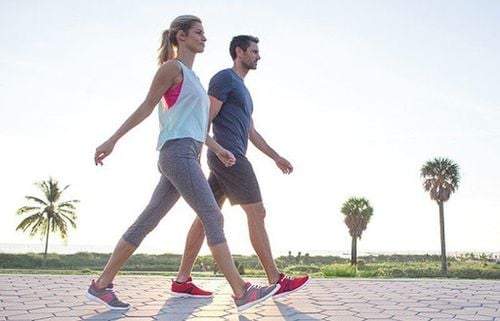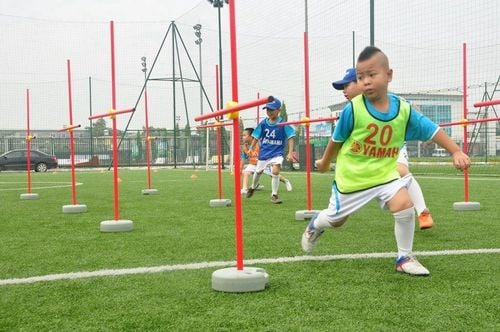If you have been running at a steady pace for a long time, you should consider improving your running speed and endurance. You can refer to the tips below to increase your speed and endurance when running.
1. Increase your speed
One of the first steps to running faster is to increase your speed. Start by increasing your speed for a short time, then return to your normal running speed. Remember, when you first increase your speed, you need to regulate your breathing. If your muscles start to tire, you need to feel the difference between discomfort and pain. If it hurts, you should slow down.
Initially, increasing your speed may make you uncomfortable. However, as you improve your mental and physical endurance, you will gradually get used to the feeling of increasing your running speed and gain experience running faster.
2. Run more frequently and consistently
In many cases, increasing your total weekly mileage will help increase your overall speed. If you usually run once a week and do other activities on other days, try increasing the number of runs per week and reducing the time spent on other activities. You will easily notice that your running speed will increase significantly.
Some athletes often run every day or can rest 1 day/week. If you choose to run this frequency, you need to pay attention to your training distance and intensity to avoid injury or burnout. If your goal is to improve your running speed, you should run at least 2-3 days/week.
3. Proper running posture
Having a proper running posture will help you run more effectively. Making small adjustments to your posture and gait will help your body move more easily, with less effort. As a result, you will have more energy to increase your running speed. A little tip for you is to relax your shoulders and let your arms swing naturally while running.

4. Count your steps
Counting your steps can help increase the number of steps per minute (equivalent to increasing your running speed). From there, you can run faster. To determine your step count, run for about 30 seconds at the speed you think you can maintain for about 5km - counting each time your right foot hits the ground. Then, double the number to get your overall step rate.
To increase your running speed, start by running for 30 seconds at your current speed. Then jog for 1 minute to recover and then run for another 30 seconds, this time increasing the number of steps. You should focus on running with quick, short steps. Repeat 5-8 times, trying to increase the rate of your steps each time. This will help you run faster.
5. Schedule a tempo run
Tempo running (running at a constant pace, sustained at a higher-than-average speed) or running at a slightly slower pace than your usual pace will help you run faster. Experienced runners typically incorporate a tempo run into their training schedule at least once a week.
To perform a tempo run, begin with a 5-10 minute easy warm-up. Then, continue running for 15 - 20 minutes at a pace of about 10 seconds/1 mile slower than your usual pace. Conclude with a 5-10 minute cool-down. The effort during the tempo portion should feel "comfortably uncomfortable". You shouldn't be running so easily that you can chat effortlessly, nor so hard that you are gasping for air.
6. Choose speed workouts
Choosing speed workouts is one of the smartest ways to improve your speed. This is because speed workouts will help you move faster, running at a higher speed.
You should try speed workouts once a week. There are other workouts that you can also incorporate into your training. You can do them on a regular running track or a treadmill to accurately track your distances as you train.
7. Run Fartleks
If you don’t have access to a track or a place where you can accurately measure your running distances, you can replace them with distance training. Fartleks are a good option. Fartleks is a Swedish word that means “speed game”. There are simple ways to incorporate Fartleks into your running sessions and help you improve your running speed.
If you are running on the road, you can use lamp posts or telephone poles to mark your intervals. After warming up, try sprinting the length of two lamp posts, then recovering for the length of two lamp posts, and then repeating this until you have run about a mile.
Or if you like listening to music while running, sprint through the chorus of the song. This acceleration will help you get used to it and become more comfortable running at a higher speed.

8. Incorporate hill or slope running
Running on hills or slopes will significantly improve the efficiency of the running process, helping you run faster. Specifically, repeating the running movements up and down hills is a great way to help you catch up with your running pace. You can incorporate hill or slope running into your running program after building a foundation of endurance.
You should try to practice running on hills or slopes once a week. Start with a 10 - 15 minute light jog warm-up. Find a hill or slope with a moderate slope, about 100 - 200m long. Then, run uphill at a steady pace. Come back and recover by jogging or walking downhill.
9. Run on a Treadmill
Although training on open roads is preferred by many runners, you can also use a treadmill to improve your running speed. In general, running on a treadmill is easier than running outdoors. On a treadmill, the belt moves under your feet, so you need to use less effort. In addition, running on a treadmill at home does not have the effects of wind or changing terrain that can challenge your movement. However, you can set the incline of the machine to 1 - 2% to simulate the factors that affect the terrain on running.
One benefit of using a treadmill is that you can train yourself to turn your feet quickly and easily. From there, you will have better running skills. In addition, treadmills also have interval running and running uphill with higher precision.
10. Allow your body to recover
Don't think that running hard every day will make you run faster. Rest is also very important to help your body recover and prevent injury. You may find that you run faster if you take at least 1 day off from training per week.
On recovery days, you can still participate in physical activities but do exercises that are not too strenuous. Resting also improves your mood and is good for your brain. In addition, your muscles will recover during rest days.
11. Have a clear training plan
If you feel overwhelmed by the thought of scheduling all your speed and endurance exercises at once, you can create a simple training plan for a more focused and organized workout. Specifically, choose a plan that targets a specific distance that you need to do. From there, you will improve your running speed and endurance.
12. Consider your BMI
Overweight people, defined as having a body mass index (BMI) of 25.0 or higher, can improve their running speed by losing weight. Some estimates suggest that athletes who lose 1 pound can run 2 seconds faster per mile. Of course, that doesn't mean you have to lose weight if you're happy with your figure and don't have any underlying health problems.
So it's a good idea to consult your doctor before embarking on a weight loss plan. They can advise you on how much weight you should lose or suggest safe weight loss methods for you.

13. Change your eating habits
Research shows that improving your diet can also help increase your running speed. Eating enough protein will help build strong muscles; consuming the right amount of complex carbohydrates will fuel your workouts; eating the right type of fat will help maintain healthy joints.
Exercisers should evaluate their calorie intake and macronutrient balance to see if they fit within the recommended intake for a balanced diet. You should eliminate foods that do not provide much nutrition and should consult a nutritionist to ensure you consume the necessary amount of nutrients.
Calorie-dense foods (sweets, soft drinks, tea, fried foods, baked goods, processed foods) should be eliminated. At the same time, meals should be healthy and balanced with nutrient-dense foods such as lean proteins, vegetables, healthy fats, and whole grains.
14. Wear lightweight running gear
Some running gear adds bulk to your body, slowing you down and hindering your running performance. Therefore, you should buy equipment made of lightweight fabric or materials. At the same time, you should consider buying a pair of faster and lighter running shoes.
Of course, there is still some equipment that you must carry while running, especially for long runs. These items can be a mobile phone (to call for help if necessary) and water to keep your body hydrated. Your health and safety are always more important than improving your running speed.
15. Stretch your joints regularly
Inflexible joints can slow down your running speed. You will not be able to run fast if your body has a limited range of motion. In addition, tight muscles can also make you more susceptible to injury. If you are injured, your running speed will decrease significantly until you recover.
Therefore, you should pay attention to stretching your muscles and joints, and try to stretch after each run. While you don't need to spend too much time doing exercises, dedicating 5-10 minutes post-run to stretching your calves, hip flexors, and quadriceps can improve your range of motion and contribute to enhanced running performance.
16. Strengthen your core muscles
The strength of your core muscles can affect your running speed. Stronger abdominal muscles will improve your running posture, help you breathe more effectively, free up your legs to run longer and more durable. Therefore, you should try adding a few exercises for the weak muscle group to your daily exercise routine. It can be doing planks, holding for about 1 minute or longer. In addition, you can also choose other forms of exercise such as sit-ups, playing shuttlecock, etc. at the end of the run.
17. Get enough sleep
Fast runners are usually well-rested. Therefore, one of the best ways to improve running performance is to get enough sleep. Healthy adults should sleep 7-9 hours a night. In addition, you should form a habit of going to bed at the same time every night, remove electronic devices from the bedroom area, and lower the temperature a bit to sleep better.

18. Weight training
Weight training improves muscle strength, which will help increase the body's overall speed and performance. It also helps you reduce the risk of injury while running. Therefore, you should try to do endurance training 1-2 times a week. If you don't have the conditions to go to the gym, you can just do physical exercises at home such as push-ups or squats, etc. to build muscle. If possible, you should do these exercises right after running.
19. Experiment with resistance
You can use training aids such as anti-gravity treadmills or speed ropes to increase your strength and performance. A running belt - which creates resistance for your stride - is a tool that can help improve your running speed. If you want to experiment, you should talk to a trainer to get instructions on how to use the tools correctly to avoid the risk of injury.
20. Cross-training
Although running exercises help improve the speed of the exerciser, sometimes the best way to improve running speed is to take a break and switch to other exercises.
Cross-training can include CrossFit, swimming, soccer, etc. They help you improve your cardiovascular endurance. In addition, it also helps increase flexibility and range of motion of the joints, helping to increase overall strength. At the same time, cross-training also helps you relax your mind after running.
21. Run with a group
Running with a group will push you to work harder. There are many ways to find a running group, usually in your area or at your office, gym, etc.
22. Speeding at the end
You can push yourself like you are in a race. This is a fast sprint to the finish line at the end of your run. During the last few kilometers of your long run, you can gradually increase your speed, especially increasing your speed by about 20 - 30 seconds for the last mile or so. This will help improve your endurance.
If you are ready to increase your endurance and train your body to run faster, try incorporating any of the above tips into your running routine. And whether you are a new runner or an experienced runner, remember to listen to your body. If any exercise causes pain or discomfort, you should stop immediately. In addition, some of the tips above may not be recommended if you have certain medical conditions. Therefore, you should consult your doctor before starting any new exercise program.
To arrange an appointment, please call HOTLINE or make your reservation directly HERE. You may also download the MyVinmec app to schedule appointments faster and manage your reservations more conveniently.
Reference source: verywellfit.com













